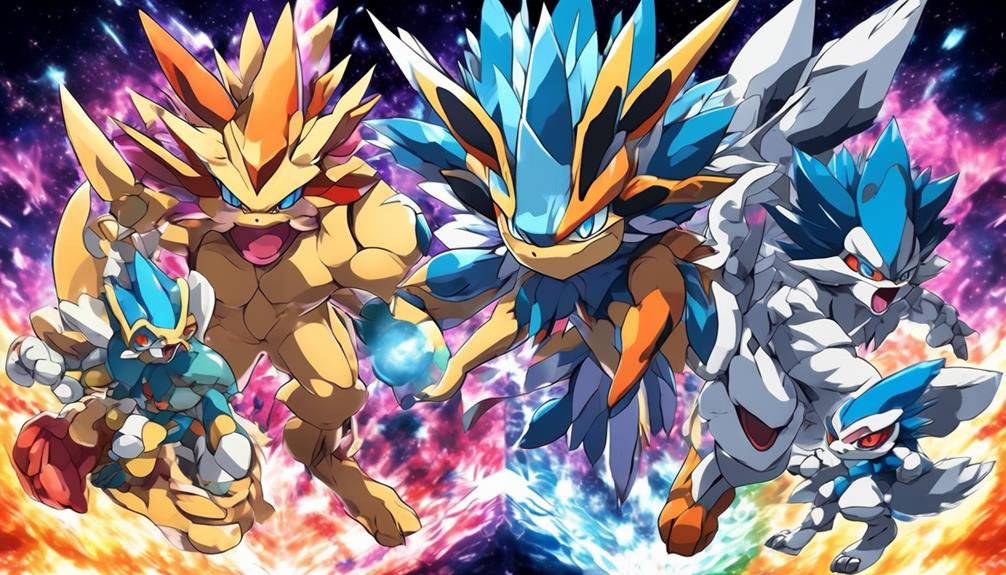Like a caterpillar transforming into a magnificent butterfly, the evolutionary stages of Pokemon take these creatures on a captivating journey of growth and development.
From their humble beginnings as basic stage Pokemon, they undergo wondrous transformations, each stage bringing them closer to their final, awe-inspiring evolution.
But what are these stages exactly? How do Pokemon progress from one stage to another? And what secrets do these evolutions hold?
Prepare to embark on a fascinating exploration of the evolutionary stages of Pokemon, where mysteries and revelations await at every turn.
Basic Stage Pokemon

What are the defining characteristics of Basic Stage Pokemon and how do they differ from their evolved forms?
Basic stage Pokemon are the initial form of a Pokemon and serve as the foundation for their evolutionary line. They're the starting point of a Pokemon's journey towards becoming stronger and more powerful. Basic Pokemon have the lowest stats compared to their evolved counterparts, making them less formidable in battles. However, their simplicity and ease of capture make them accessible to trainers of all levels.
Their move sets and abilities are usually straightforward and uncomplicated, lacking the complexity and diversity seen in their evolved forms. In terms of evolution, basic Pokemon require less experience to level up and evolve into their next stage. This means that trainers can witness the growth and development of their Pokemon relatively quickly. Some basic Pokemon have unique methods of evolution, such as evolving through friendship or knowing specific moves. These unique evolution methods add an element of intrigue and excitement to the evolution process.
First Evolution Pokemon

First evolution Pokemon, also known as initial form Pokemon or stage 1 Pokemon, are the starting point in a Pokemon's evolutionary line. These Pokemon are typically obtained through catching them in the wild or hatching them from eggs.
They possess lower base stats and fewer abilities compared to their evolved forms, and they require experience points to level up and eventually evolve into their second form.
Initial Form Pokemon
Initial Form Pokemon, also known as first evolution Pokemon, serve as the foundational stage in a Pokemon's evolutionary line, laying the groundwork for their future development and potential. These Pokemon start with lower base stats and fewer abilities compared to their evolved forms. However, they've the potential to evolve into more powerful forms by meeting specific conditions such as reaching a certain level or using evolutionary stones.
The evolutionary process is crucial as it can result in these Pokemon gaining different abilities and typings, enhancing their battle capabilities. The inclusion of Initial Form Pokemon in a team adds strategy and depth to the gameplay, as their evolution leads to the development of a diverse and powerful team.
This process of evolution is what makes the concept of Pokemon evolution lines so fascinating and integral to the overall Pokemon experience.
Stage 1 Pokemon
As Pokemon progress from their initial forms, they undergo a significant transformation, evolving into Stage 1 Pokemon, which mark the first evolutionary stage of their species. Stage 1 Pokemon are the first evolution of a Pokemon species, typically evolving from a basic form. These Pokemon often have two evolutionary stages and can further evolve into Stage 2 forms by leveling up or meeting specific conditions.
Although Stage 1 Pokemon generally have lower base stats and capabilities compared to their evolved forms, they play an essential role in a trainer's team. They possess unique abilities and moves that differentiate them from their later evolutionary stages, providing diverse strategic options in battles. Building a diverse and balanced team is crucial, and Stage 1 Pokemon offer a range of moves and types to complement other Pokemon in a trainer's lineup.
Second Evolution Pokemon

Second Evolution Pokémon serve as an intermediary stage between the basic form and the final form in a Pokémon's evolutionary line, offering significant stat boosts and new moves upon evolving. These Pokémon typically represent a mid-point in a Pokémon's development, showcasing their potential before reaching their final form.
As a Pokémon Trainer, having second evolution Pokémon on your team can provide a balance between power and agility, making them a crucial part of your strategy.
Here are three reasons why second evolution Pokémon are an important part of your team:
- Stat Boosts: Second evolution Pokémon often experience substantial increases in their base stats when they evolve. This means they become stronger, faster, and more resilient, making them formidable opponents in battle.
- New Moves: Upon evolving to their second form, these Pokémon gain access to a wider move pool. This allows them to learn powerful and strategic moves that can turn the tide of a battle in your favor.
- Versatility: Second evolution Pokémon unlock new abilities and sometimes even change their types, making them versatile additions to your team. This versatility allows you to adapt to different types of opponents and employ different strategies to secure victory.
Final Evolution Pokemon

The final evolution Pokémon represents the ultimate stage of a Pokémon's evolutionary line, showcasing their maximum potential in terms of power, abilities, and strategic versatility. These Pokémon are revered for their superior strength and are often the pinnacle of a Trainer's team.
With higher base stats, improved abilities, and a wider movepool, final evolution Pokémon possess the necessary tools to excel in battles. Their enhanced stats provide them with a significant advantage over their previous stages, allowing them to dominate in competitive play, gym battles, and the Pokémon League.
What sets them apart isn't only their strength but also their unique traits. Final evolution Pokémon may gain access to exclusive moves, signature abilities, and unique typings, making them even more formidable.
Obtaining and training these Pokémon is a milestone for Trainers, reflecting their dedication and progress in mastering their team. By harnessing the power of final evolution Pokémon, Trainers can truly showcase their skills and achieve a sense of belonging in the Pokémon world.
Mega Evolution Pokemon

Mega Evolution, a temporary transformation triggered by a special item known as a Mega Stone, significantly enhances a Pokémon's powers and changes its abilities during battles. This unique form is only temporary, as the Pokémon reverts back to its original state once the battle ends. Mega Evolution is an exciting element of the Pokémon world, providing a tactical advantage and altering the flow of combat.
Here are some key features of Mega Evolution:
- Visual Transformation: Mega Evolution Pokémon undergo a stunning visual transformation, showcasing unique designs that often indicate a significant power boost. The changes can range from subtle alterations to dramatic shifts in appearance.
- Enhanced Powers: Mega Evolution grants Pokémon a substantial increase in their base stats, boosting their offensive and defensive capabilities. This power boost allows them to perform at a higher level during battles, giving trainers an edge in strategic gameplay.
- Altered Abilities: Along with enhanced stats, Mega Evolution Pokémon also gain new and improved abilities. These abilities can range from increased speed or strength to accessing exclusive moves that were previously unavailable.
Mega Evolution is a captivating aspect of the evolutionary stages of Pokémon. With its temporary transformation and amplified powers, Mega Evolution adds depth and excitement to battles, making it a sought-after strategy for trainers seeking an edge in competitive play.
Gigantamax Pokemon

Gigantamax Pokemon are a unique variation of Pokemon that can only be obtained through Max Raid Battles in select games. These Pokemon have distinct appearances and often receive a boost in their stats when they Gigantamax.
Additionally, they possess special G-Max Moves that differ from regular Max Moves, giving them a tactical advantage in battle.
Gigantamax Forms
Certain Pokémon undergo a unique transformation known as Gigantamax Forms, which not only alters their appearance but also grants them access to powerful G-Max Moves with special effects. Gigantamax Pokémon have increased HP and access to special G-Max Moves, making them formidable in battles.
These Gigantamax Forms can only be obtained through engaging in Max Raid Battles in the Wild Area. By participating in these battles, trainers have the opportunity to capture and train these powerful Pokémon.
Once a Pokémon has reached its Gigantamax form, it can activate its Gigantamax powers in Max Raid Battles and Gym Battles in Pokémon Sword and Shield. This evolutionary stage brings about a significant change in the Pokémon's appearance and abilities, providing trainers with a new level of excitement and challenge.
Gigantamax Abilities
After undergoing their Gigantamax transformation, Pokemon not only alter their appearance but also develop unique Gigantamax Abilities that enhance their battle capabilities. These exclusive Gigantamax Abilities provide powerful effects during battles and can differ from the Pokemon's regular abilities. By utilizing these abilities strategically, trainers can gain a significant advantage in battles. Whether it is setting up terrain or inflicting status conditions on opponents, Gigantamax Abilities add a new layer of complexity and tactics to gameplay. Obtaining Gigantamax Pokemon is no easy task, as they can only be acquired through Max Raid Battles in specific locations. This rarity and exclusivity make Gigantamax Pokemon highly sought after by trainers who desire to belong to an elite group of skilled battlers. The table below showcases some examples of Gigantamax Pokemon and their unique Gigantamax Abilities.
| Pokemon | Gigantamax Ability | Effect |
|---|---|---|
| Charizard | Wildfire | Deals damage and continues to inflict damage |
| Pikachu | Volt Crash | Paralyzes all opponents on the field |
| Eevee | G-Max Cuddle | Causes opponents of the opposite gender to become infatuated |
| Butterfree | G-Max Befuddle | Confuses all opponents on the field |
| Meowth | G-Max Gold Rush | Earns extra money after battle |
Frequently Asked Questions
What Levels Do Pokemon Evolve?
Pokemon evolve at different levels, depending on the species. Some evolve early, like Caterpie at level 7, while others evolve later, like Dragonair at level 55. Leveling up is just one of the many methods of evolution in Pokemon.
What Pokémon Has 4 Stages?
In the world of Pokémon, there is one special species that goes beyond the usual three-stage evolution process. That Pokémon is Eevee, who has a total of four stages thanks to its unique evolution methods.
What Are the 4 Evolutions?
You have four evolutions in Pokemon. Some Pokemon evolve through the use of evolutionary stones, others evolve through trading, and there are also those with unique methods of evolution.
Does Any Pokémon Have 3 Evolutions?
Yes, Eevee has three evolutions: Vaporeon, Jolteon, and Flareon. Some Pokémon can skip an evolution stage, like Scyther evolving into Scizor. The evolution process affects a Pokémon's stats, often increasing their power and abilities.
Conclusion
In conclusion, the evolutionary stages of Pokemon are a fascinating aspect of the games, adding depth and strategy to gameplay.
From the basic stage Pokemon to the final evolution, each stage unlocks new typings and abilities, enhancing a Pokemon's power and versatility.
Additionally, Mega Evolution and Gigantamax provide temporary boosts, further expanding the potential of these creatures.
Just like the growth and transformation of Pokemon, we too can evolve and adapt in our own journeys, unlocking new skills and capabilities along the way.



